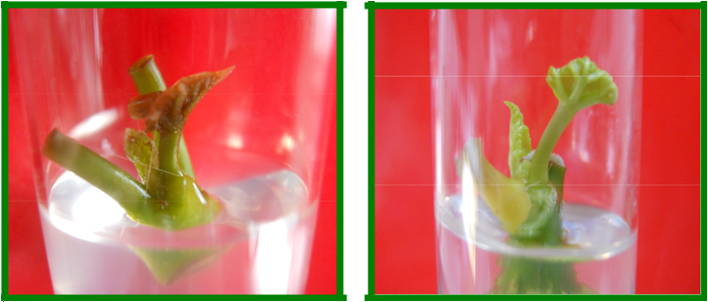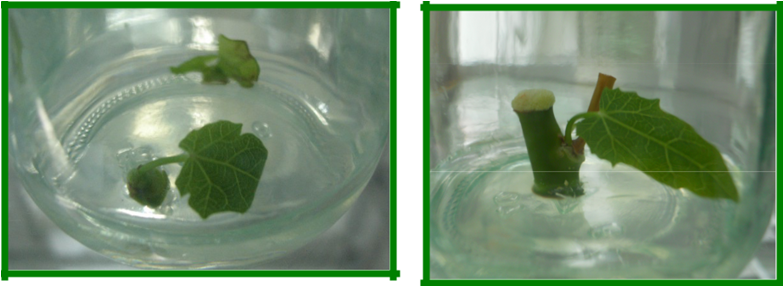Research Article
Volume 2 Issue 2 - 2020
In vitro establishment of Jatropha curcas L. starting from different types of explants.
Instituto de Biotecnología de las Plantas, Universidad Central “Marta Abreu” de Las Villas, Carretera a Camajuaní Km 5.5, Santa Clara, Cuba CP 54830
*Corresponding Author: M. Chávez, Instituto de Biotecnología de las Plantas, Universidad Central “Marta Abreu” de Las Villas, Carretera a Camajuaní Km 5.5, Santa Clara, Cuba CP 54830.
Received: May 05, 2020; Published: May 18, 2020
Abstract
The use of Jatropha curcas for biofuels production is growing rapidly worldwide. Traditional methods of propagation have failed to respond to that demand. In vitro culture could become an alternative to propagate this species on a commercial scale. From plants of different origins of the country, a bank of donors plants was established in culture house and different explants types took (apical shoots, axillaries buds and discs of leaves) that were submitted to different treatments of disinfection by sodium hypochlorite (NaOCl) during 15 minutes. In the case of the apical shoots and axillaries buds, independently of the concentration of NaOCl used, contamination by funguses microorganisms was not observed. Nevertheless, the presence of contamination by bacteria oscillated between 16 and 33%. As the concentration of the disinfectant was increased, the number of explants with necrosis in different zones of the tissue was greater, until a 21% of explants died in the treatment with 3,0% of NaOCl. The number of explants brought forth was greater in the treatment with smaller concentration (2,0%) of the disinfectant, with 83,3% in the case of the apical shoots and a 54% for the axillaries buds. In the disinfection treatments for leaf discs, NaOCl concentrations were lower (1.0, 1.5, 2.0%). It was observed with 1.0% NaOCl a 75% of microbial contamination, while 2.0% showed damage from necrosis in 58.3% of the leaf discs. The results allow for a method that guarantees the in vitro establishment different types of explants, which is a starting point in developing a protocol for the propagation of this species.
Key words: Biofuels; Disinfection; Sodium hypochlorite
The use of Jatropha curcas for biofuel production is growing rapidly worldwide. This plant is a shrub that can withstand water shortages and extreme weather conditions, as well as grow in nutrient-poor soils. As mentioned, the pinion is a multifunctional plant since its entire structure can be fully used. The latex it produces is widely used in traditional medicine, and anti-cancer properties have been reported (Shrivastava & Banerjee, 2008). Its seeds contain 35-55% oil, this oil contains a high percentage of cetane, hence its potential in the production of biodiesel (Songstad et al., 2009). It can be converted to biodiesel through a chemical reaction of transesterification, this oil is a renewable, environmentally friendly and low-cost energy source (López et al. 2011), its cultivation is also carried out as live fences in the case of small and medium producers, and it also has possibilities of application in the pharmaceutical area, this due to the presence of a protein with antitumor activity called curcin (Bermejo Cruz, 2010).
Its propagation by seed is limited by the loss of germination capacity, while vegetative propagation has the drawbacks that it reduces the longevity of the plant and limits the development of the pivoting root, in addition to the fact that plants regenerated by this route reduce their productivity (Shrivastava & Banerjee, 2008). Due to all of the above, traditional propagation methods have not been able to meet this demand and it is where in vitro culture could become an alternative to propagate this species on a commercial scale. It is in the reduced space that is needed to produce a significant number of plants from an explant, the growth time of the plants is reduced compared to their natural growth, and no matter what time of year it is planted, thus being able to carry out the rapid introduction of this species. In addition, plants are produced with controlled sanitation and the possibility of propagating the Jatropha curcas variety that presents the best oil production and quality characteristics.
In order to establish in vitro plants from different sources in the country, a bank of donor plants was established from which different types of explants were taken (apical shoots, axillary buds and leaf discs) that were subjected to different disinfection treatments with Sodium hypochlorite (NaOCl) for 15 minutes.
In the case of apical shoots and axillary buds, regardless of the NaOCl concentration used, no contamination by fungal microorganisms was observed. However, the presence of bacterial contamination ranged from 16 to 33%.
As the concentration of the disinfectant increased, the number of explants with necrosis in different areas of the tissue increased, reaching up to 21% of dead explants in the 3.0% NaOCl treatment. The number of sprouted explants was greater in the treatment with a lower concentration (2.0%) of the disinfectant, with 83.3% in the case of apical buds and 54% for axillary buds.

Figure 2: Sprouting of different types of Jatropha curcas explants after 9 days of culture. A) Apical shoots. B) Axillary buds.
With the present investigation, it was possible to establish and maintain a bank of donor plants in growing house conditions, which allowed to have plant material for the in vitro establishment of this species. Disinfection and consequently the in vitro establishment of axillary buds and apical shoots obtained from the donor plant bank were possible.
References
- López, D., L. Peñate, M. Daquinta, D. Pina, M. Escalona. Jatroha curcas culture, L. (Euphorbiaceaceae). (2011). Preliminary results and future strategies (online). Retrieved on May 6.
- Melissa Eugenia Guadalupe Bermejo Cruz, (2010). In vitro culture of Jatropha curcas to obtain curcina. Master of Science in Biotic Product Development.
- Misra, P; Gupta, N; Toppo, D; Pande, V; Mishra, M; Tuli, R. (2010). Establishment of long-term proliferating shoot cultures of elite Jatropha curcas L by controlling endophytic bacterial contamination. Plant Cell Tiss Organ Cult. 100: 189-197.
- Shrivastava, S., & Banerjee M. (2008). In vitro clonal propagation of physic nut (Jatropha curcas L.): Influence of additives. International Journal of Integrative Biology, [Electronic Version], 3 (1), 73-79.
- Songstad D, Lakshmanan P, Chen J, Gibbons W, Hughes S & Nelson R. (2009). Historical perspective of biofuels: learning from the past to rediscover the future. In Vitro Cell. Dev. Biol. -Plant. 45: 189-192.
Citation: M. Chávez and M. de Feria. (2020). In vitro establishment of Jatropha curcas L. starting from different types of explants. Journal of Biotechnology and Immunology 2(2).
Copyright: © 2020 M. Chávez. This is an open-access article distributed under the terms of the Creative Commons Attribution License, which permits unrestricted use, distribution, and reproduction in any medium, provided the original author and source are credited.


